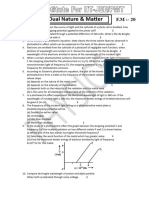Assignment 2
Uploaded by
Ray RenoldAssignment 2
Uploaded by
Ray RenoldPH6011 Physics and Technology of Solid State
Assignment 2
Submission date: 15-09-2024
𝐴
1 The coulomb interaction energy between two adjacent ions in a solid is given by − 𝑟 (esu).
𝐵
Assuming the repulsive energy to be of the form 𝑟 𝑛 , find the bonding energy at equilibrium and
the bond length of the system.
2. Given the Debye frequency of sodium as 3.3 1012 Hz, calculate its molar specific heat at
10 K assuming Debye’s T3 law
3. If the velocity of sound in a solid is of the order of 103m/s, compare the frequency of the
sound wave = 10 Å for (a) a monoatomic system, and (b) acoustic waves and optical waves
in a diatomic system containing two identical atoms (M = m) per unit cell of interatomic
spacing 2.5 Å.
4. Consider a one-dimensional chain of diatomic solid where all the masses along the chain are
the same (M = m) but the two spring constants f1 and f2 are different. Find out the dispersion
relation and analyse their optical and acoustic frequencies of lattice vibrations.
5. Debye temperature of sodium chloride is 288 K, Calculate the maximum frequency of
vibration of the phonons and the specific heat at a constant volume of NaCl at 20 K.
6. Lead has an FCC structure with a lattice constant of 0.494 nm. Young’s modulus of lead is
1.6 1010 N/m2. If the lead melts when the average amplitude of atomic vibrations is 15.8 per
cent of the interatomic spacing, compute the melting point of lead.
You might also like
- Lattice Vibrations - Phonons in Solid State: Alex Mathew, University of RochesterNo ratings yetLattice Vibrations - Phonons in Solid State: Alex Mathew, University of Rochester3 pages
- Bonga University: Engineering Material (Meng2091)No ratings yetBonga University: Engineering Material (Meng2091)30 pages
- Grantham - The Fabric of Space As An Electron-PositronNo ratings yetGrantham - The Fabric of Space As An Electron-Positron5 pages
- Modern Physics-06-Subjective Unsolved LevelNo ratings yetModern Physics-06-Subjective Unsolved Level3 pages
- Department of Electrical Engineering Indian Institute of Technology, Kanpur EE 311 Home Assignment #2 Assigned: 16.1.23 Due: 23.1.23No ratings yetDepartment of Electrical Engineering Indian Institute of Technology, Kanpur EE 311 Home Assignment #2 Assigned: 16.1.23 Due: 23.1.231 page
- Plasmonic Coupling in Noble Metal NanostructuresNo ratings yetPlasmonic Coupling in Noble Metal Nanostructures12 pages
- Tut-sheet-1-PHL120-13 With Final Answers PDFNo ratings yetTut-sheet-1-PHL120-13 With Final Answers PDF3 pages
- Structure Ferroelectric Properties and Magnetic Properties of TNo ratings yetStructure Ferroelectric Properties and Magnetic Properties of T5 pages
- Class:12 Physics Assignment 3 Topic: Dual Nature of Matter and RadiationNo ratings yetClass:12 Physics Assignment 3 Topic: Dual Nature of Matter and Radiation2 pages
- For Class 12 Students Pratical - Coulomb-s-LawNo ratings yetFor Class 12 Students Pratical - Coulomb-s-Law37 pages
- Correlated Insulator of Excitons in WSe2WS2No ratings yetCorrelated Insulator of Excitons in WSe2WS25 pages
- Quantum Mechanics de - Broglie Matter WavesNo ratings yetQuantum Mechanics de - Broglie Matter Waves16 pages
- Questions and Answers: X-Ray Photoelectron Spectroscopy: An Introduction To Principles and PracticesNo ratings yetQuestions and Answers: X-Ray Photoelectron Spectroscopy: An Introduction To Principles and Practices7 pages
- Negative Mass and Negative Refractive Index in Atom Nuclei - Nuclear Wave Equation - Gravitational and Inertial Control: Part 3: Gravitational and Inertial Control, #3From EverandNegative Mass and Negative Refractive Index in Atom Nuclei - Nuclear Wave Equation - Gravitational and Inertial Control: Part 3: Gravitational and Inertial Control, #3No ratings yet



























































